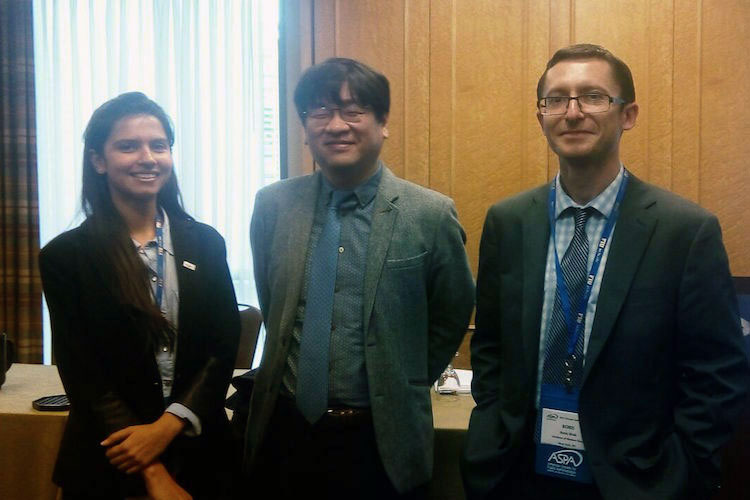Last week, the American Society for Public Administration (ASPA) held its annual conference in Chicago, Illinois. At the panel titled “Comparative Approaches to E-Government,” IMR researcher Boris Bruk spoke about the trend of e-democracy development in Russia.

Participants in APSA conference (left to right): Kinjal Chaudhary, Sam Youl Lee and Boris Bruk.
When IMR researcher Boris Bruk spoke at the recent annual conference for the American Society for Public Administration (ASPA), he discussed the trend of e-democracy, citing several of its manifestations, including e-voting, e-participation, and e-mobilization. He noted that literature on the topic distinguishes between “e-democracy from above” and “e-democracy from below.” Internationally, official discussions of e-democracy are often reduced to ones of e-government. At present, the mechanisms of Russian “e-democracy from above” can be described as imitational in nature, which may seem especially obvious in the context of the Russian government’s strengthened control over the Internet. The alternative, “e-democracy from below,” has been created by the efforts of Russian civil society. According to Bruk, a number of Internet platforms offer Russian citizens the opportunity to participate in solving common socially significant problems. Examples of such platforms include Alexei Navalny’s RosPil and Mikhail Khodorkovsky’s Open Russia.
The panel at which Bruk spoke also featured presentations by scholars and researchers from Korea, China, and India. Professor Sam Youl Lee of Yonsei University spoke about a collaborative research study on innovations introduced by the Seoul Metropolitan Government. The broader focus of the study is on examining the role of social media and its effect on organizational culture. As Lee pointed out, one of the important initiatives launched by the Park Won-soon administration was the establishment of the Social Media Center. Currently, the government extensively uses information it receives from citizens via social media to solve specific issues and develop administrative solutions.
Somewhat different results were achieved in China, where the government launched the online forum E-Polity Square. According to Wei Zhang, a PhD candidate at the University of Nebraska, despite certain successes of the initiative, the quality of citizen input has often been quite low and communication between the government and citizens has been limited.
Speaking about India’s experiences, Kinjal Chaudhary, a graduate student at the School of Liberal Studies of Pandit Deendayal Petroleum University, said that the Indian government has made significant investments in advancing e-governance in the country. In many cases, though, the set goals have not been achieved because of such issues as a lack of citizen awareness, poor infrastructure, and technological illiteracy. Despite these issues, in India, e-governance is considered the key to good governance aimed at reducing the level of corruption and providing quality services to the people.
Quality of governance was at the center of discussion at a number of other panels. According to Leo Huberts, a professor of public administration at the VU University Amsterdam, quality of governance may be based on such values as democracy, responsiveness, effectiveness, efficiency, rule of law, and integrity. Additionally, according to a number of participants in the conference discussions, good governance immediately involves such values as openness and transparency.
In that regard, the presentation of Suzanne Piotrowski, associate professor of public affairs and administration at Rutgers University-Newark, was especially interesting. Piotrowski spoke about the Open Government Partnership (OGP), the largest international organization focused on questions of open government. The OGP’s goal is to improve the quality of governance and to increase governance transparency. To a significant extent, the OGP, which was announced at the 66th Session of the United Nations General Assembly, has continued president Barack Obama’s commitment to open government (the American president launched the open government initiative in 2009). Sixty-five countries are current members of the OGP; Russia withdrew from membership in 2013. Speaking about America’s experience with the implementation of OGP commitments, Piotrowski emphasized the important role of civil society organizations. For example, OpenTheGovernment.org not only provides input to the commitments agenda, but also performs an oversight function.
The important conclusion that was reached in a number of ASPA sessions is that organizations have increasingly turned to innovation to improve the quality of governance. At the organizational level, innovative behavior is largely dependent on leadership. According to Montgomery van Wart, professor of public administration at California State University, San Bernardino, successful implementation of innovation requires a number of “pragmatic steps that increase the likelihood of success in implementing innovation and reform.” These steps include (but are not limited to) creating a supportive environment for innovation; ensuring internal support for implementing innovation; providing a realistic strategy for innovation or reform; institutionalizing changes; and evaluating innovations.
ASPA is the world’s leading professional organization in public administration. The next ASPA conference will be held on March 18–22 in Seattle, Washington.

